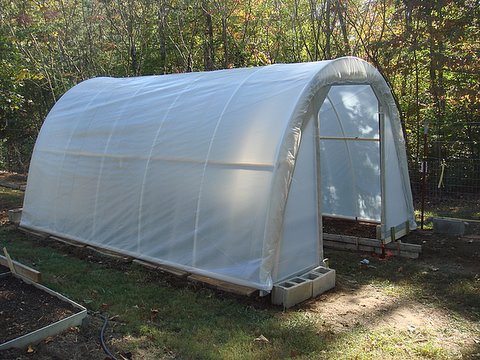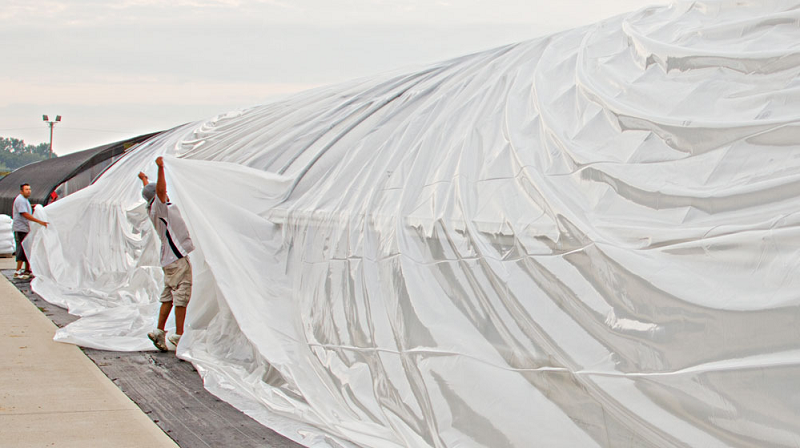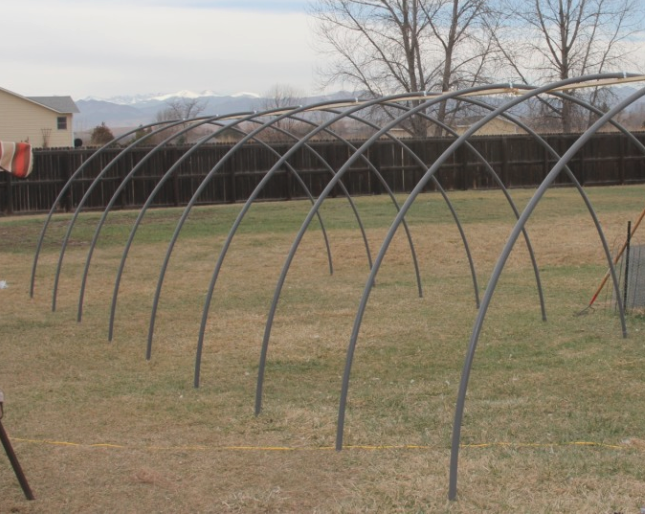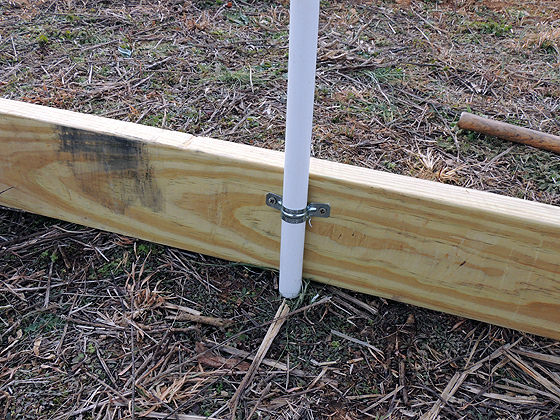











Our tutorial will help you construction a greenhouse hoop house from plastic sheeting! If you already have your plans and are just looking for plastic, check out our 'Supplies' section below for webstore links.

There is a wide variety of plastic sheeting for greenhouses. The type that is best for you will depend on the specifics of your installation. If you are using a quick low-cost build like our tutorial, it may be best to invest in something economical like our standard 6 mil or 10 mil. The plastic will have to be changed out occasionally, but this is not a difficult task with a simple design. If you are doing a more complex, permenant construction with a wooden frame, you will definitely want to use professional grade UV-inhibiting plastic that will last as long as possible.
• Plastic sheeting
• Economical 6 mil plastic
• Extra Durable 10 mil plastic
• Professional 6 mil UVA (20' x 50') plastic
• Professional 6 mil UVA no-drip (40' x 100') plastic
All have free shipping!
• 3/4" x 20' PVC, one per arch plus 1-3 lengthwise supports.
• Rebar, cut to 4-5', 2 per arch.
• Snap clamps for 3/4 PVC, 6 per end arch and 2 per inner arch
• Rigid strap fasteners, 2 per arch
• Corner braces, 4
• Zipwall Door Zippers
• Cable ties (or PVC connectors)
• PVC primer and glue (if using PVC connectors)
• 2" x 4"s, cut to perimeter
• Optional: Poly patch tape (helpful in securing connections)
• Optional: Epoxy anchoring adhesive (Liquid Nails, Sika Anchorfix, etc)

There are a lot of different options for building a greenhouse. The most basic is simple PVC/rebar draped with plastic and secured with plastic clamps. Your local home store can cut the rebar for you, or you can it yourself with a hacksaw, reciprocating saw, or bandsaw (equipped with blade for 'mild steel'.) This is a fairly simple tutorial, but there are some different options and fittings available. Before buying supplies, carefully read through the directions and decide on the best style for your needs. If you are in an area with heavy winter snowfall or high winds, you will need more spine support, more arches, and the 'optional' upgrades like anchoring adhesive and extra clamps.
1. Find the ideal spot.
Choose flat, level area that gets plenty of sunlight, but is protected from strong winds.
2. Rebar stakes.
Once you have determined the footprint of your greenhouse, drive rebar stakes into the ground at all four corners. The stakes should go 2 to 3 feet into the ground with anywhere from 1 to 3 feet protruding above ground (taller/wider structures will need more height.) Test the rebar height with a single arch before driving down the rest of the stakes. Next, decide how far apart the support "ribs" will be. This can range anywhere from 2 to 4 feet depending on the strength of the wind and the amount of snow/rainfall in your area. If your region experiences more than 4 inches of snow, place the stakes closer together. Then, drive additional rebar stakes down the length of the footprint of the greenhouse, one on each side for each support rib.

3. Roof frame.
Cut all of your PVC to the size you tested in Step 2. You may keep the whole 20' length if that works for your build. Slide them over each stake. If you bought epoxy construction adhesive, coat the rebar in it before sliding on the PVC to add additional strength.
4. Center support.
At this point, a center support 'spine' brace along the top can be added to provide additional stability. If you live in an area with moderate snowfall, you will need to add at least 3 spines along the ribs to prevent collapse. You can use cable ties or wire ties to temporarily secure the spines (they will be clamped in place in a later step.) Alternatively, you can use a 4 way cross PVC fitting connector to join the ribs to the spines cleanly with PVC primer and cement. This will make your structure stronger but it is a bit more difficult.

4. Door walls.
Snap plastic to the front and back ribs with snap clamps, leaving a little extra at the top (to prevent plastic from pulling out) and an extra foot or two at the bottom. You may need to fold the plastic at the top in order to make the snap-clamps hold firmly. Wrap the excess bottom plastic in 2" x 4"s until the plastic becomes tight along the frame of the structure. Screw the wood through the wrapped plastic. Now that your bottom is firmly secure, adjust the top clamps as needed to make the wall taut. Once the door walls are complete, use Zipwall Door Zippers or a similar product to create a secure, re-usable door flap.

4. Side walls.
Drape the plastic sheeting over the frame. Leave an extra foot or two on the sides to help secure the plastic and trim any excess. Use your snap clamps to secure the plastic to the front and back ribs, over your previous work. You may want to use poly patch tape here to make this connection extra secure (poly patch tape is UV and weather resistant.) As before, take the excess bottom plastic and roll it around a 2" x 4" until the plastic becomes tight along the base of the structure. Use your rigid straps to securely attach the wrapped wood to the PVC rebar ribs on each side. As a final step, screw the door wall ground wood to the side wall ground wood using your corner braces.